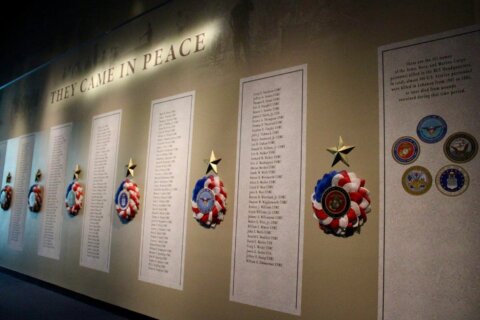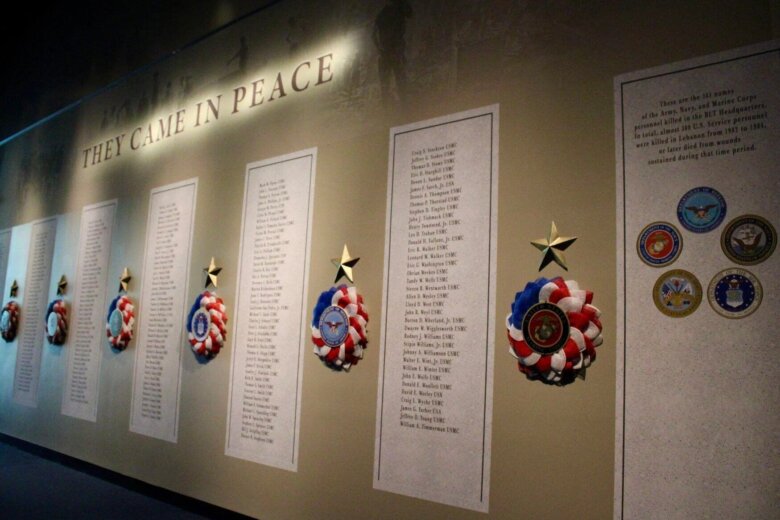This article was republished with permission from WTOP’s news partner InsideNoVa.com. Sign up for InsideNoVa.com’s free email subscription today.

This article was written by WTOP’s news partner, InsideNoVa.com, and republished with permission. Sign up for InsideNoVa.com’s free email subscription today.
A new temporary exhibit at the National Museum of the Marine Corps remembers the 241 soldiers, sailors and Marines who lost their lives in a tragic event 40 years ago.
The exhibit, “They Came in Peace,” tells the stories of the Marines who conducted peacekeeping operations in Beirut, Lebanon, from 1982 to 1984 and the 22nd Marine Amphibious Unit that landed on Grenada in 1983 as part of Operation Urgent Fury. The exhibit highlights the Marine Corps’ flexibility and the force’s readiness in Lebanon and Grenada.
In 1982, the Marine Corps began a peacekeeping mission as part of a multinational force in Lebanon. The Marines and sailors on peacekeeping duty suffered 11 killed and 64 wounded from battle before Oct. 23, 1983.
On that day, a suicide bomber in a 5-ton truck loaded with 2,000 pounds of explosives drove into the lobby of the Battalion Landing Team’s headquarters building in Beirut. The explosion and building collapse claimed the lives of three soldiers, 18 sailors and 220 Marines, making the event the greatest single-day loss of Marines since the Battle of Iwo Jima in 1945.
Less than a week before the attack, the 22nd Marine Amphibious Unit sailed from North Carolina to the Mediterranean for a training exercise in Spain, but changed course toward the Caribbean at midnight on Oct. 20, 1983, to partake in Operation Urgent Fury, the invasion of the island of Grenada. That was the largest U.S. military operation at the time since the Vietnam War.
The mission was to evacuate hundreds of American citizens and restore order after the outbreak of politically motivated violence. The amphibious unit launched its invasion on Oct. 25 and remained on the island until withdrawing to relieve the 24th Marine Amphibious Unit in Lebanon on Nov. 2, 1983, and began peacekeeping operations in Beirut thereafter.
“We try to give visitors an overview of what was going on without overwhelming them because it was an incredibly complicated situation, and for the Marine Corps it was a very hectic time,” said the exhibit’s lead curator, Gretchen S. Winterer.
Winterer said the exhibit was designed to show visitors the effect the Beirut bombing has to this day.
“It’s been a long time, but the Marine Corps doesn’t forget about these men that lost their lives,” she added. “It was such a pivotal time.”
Winterer’s father was in the Marine Corps in Grenada and landed in Beirut after the bombing. She lived outside of Camp Lejeune in North Carolina and frequented the Beirut Memorial, where she drew inspiration for the exhibit, even naming the exhibit after the memorial.
The exhibit features a memorial wall with the names of the service members who were killed in the incident and a multimedia presentation with footage of the bombing and interviews with Marines and family members who lost loved ones.
“For me, it’s very impactful because you see the magnitude and the numbers of the Marines that were lost,” she said.
The museum will feature a permanent Grenada and Beirut exhibit in its post-Vietnam gallery, currently under construction. The temporary exhibit opened Sept. 25 and will run through February 2025.








